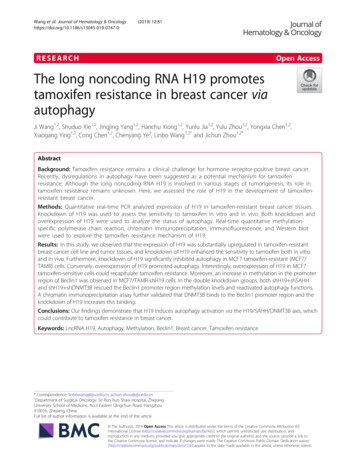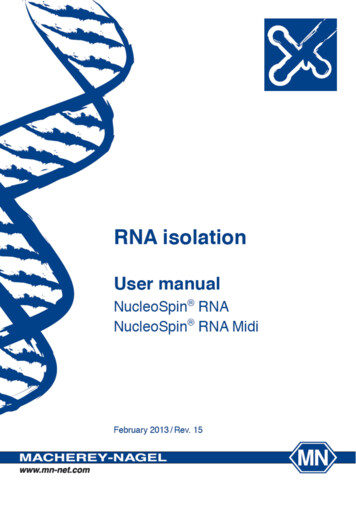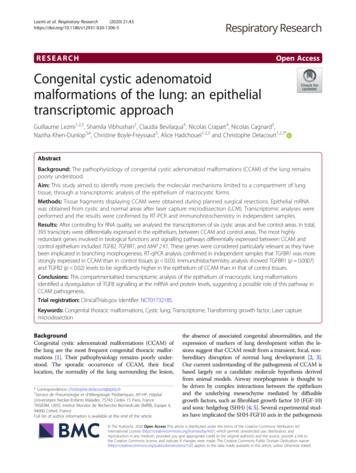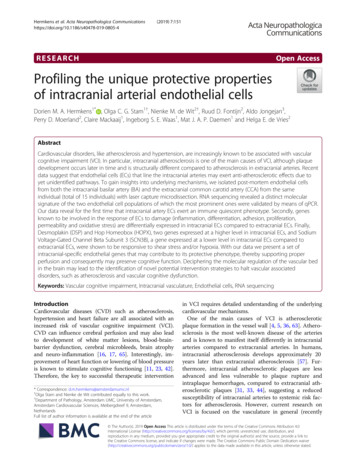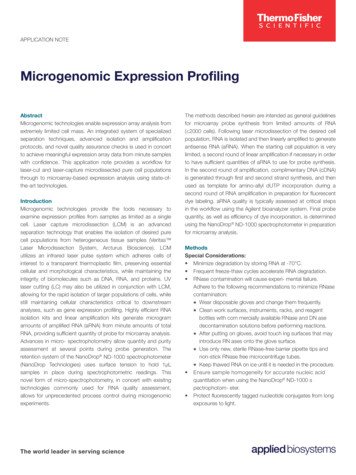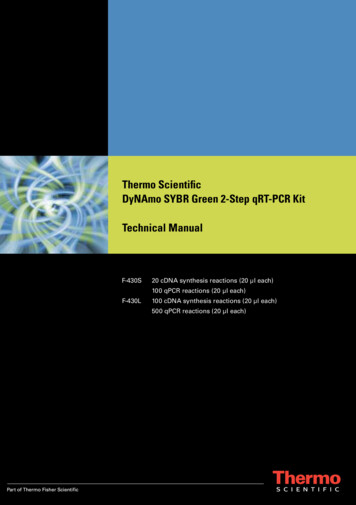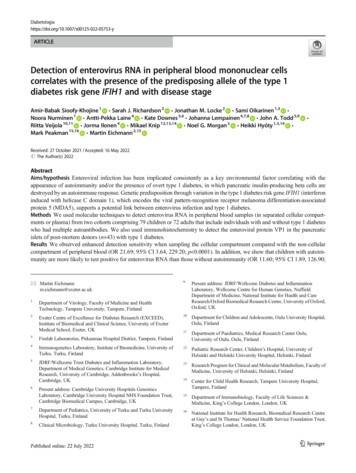
Transcription
53-yARTICLEDetection of enterovirus RNA in peripheral blood mononuclear cellscorrelates with the presence of the predisposing allele of the type 1diabetes risk gene IFIH1 and with disease stageAmir-Babak Sioofy-Khojine 1 & Sarah J. Richardson 2 & Jonathan M. Locke 2 & Sami Oikarinen 1,3 &Noora Nurminen 1 & Antti-Pekka Laine 4 & Kate Downes 5,6 & Johanna Lempainen 4,7,8 & John A. Todd 5,9Riitta Veijola 10,11 & Jorma Ilonen 4 & Mikael Knip 12,13,14 & Noel G. Morgan 2 & Heikki Hyöty 1,3,14 &Mark Peakman 15,16 & Martin Eichmann 2,15&Received: 27 October 2021 / Accepted: 16 May 2022# The Author(s) 2022AbstractAims/hypothesis Enteroviral infection has been implicated consistently as a key environmental factor correlating with theappearance of autoimmunity and/or the presence of overt type 1 diabetes, in which pancreatic insulin-producing beta cells aredestroyed by an autoimmune response. Genetic predisposition through variation in the type 1 diabetes risk gene IFIH1 (interferoninduced with helicase C domain 1), which encodes the viral pattern-recognition receptor melanoma differentiation-associatedprotein 5 (MDA5), supports a potential link between enterovirus infection and type 1 diabetes.Methods We used molecular techniques to detect enterovirus RNA in peripheral blood samples (in separated cellular compartments or plasma) from two cohorts comprising 79 children or 72 adults that include individuals with and without type 1 diabeteswho had multiple autoantibodies. We also used immunohistochemistry to detect the enteroviral protein VP1 in the pancreaticislets of post-mortem donors (n 43) with type 1 diabetes.Results We observed enhanced detection sensitivity when sampling the cellular compartment compared with the non-cellularcompartment of peripheral blood (OR 21.69; 95% CI 3.64, 229.20; p 0.0001). In addition, we show that children with autoimmunity are more likely to test positive for enterovirus RNA than those without autoimmunity (OR 11.60; 95% CI 1.89, 126.90;* Martin Eichmannm.eichmann@exeter.ac.uk9Present address: JDRF/Wellcome Diabetes and InflammationLaboratory, Wellcome Centre for Human Genetics, NuffieldDepartment of Medicine, National Institute for Health and CareResearch/Oxford Biomedical Research Centre, University of Oxford,Oxford, UK10Department for Children and Adolescents, Oulu University Hospital,Oulu, Finland11Department of Paediatrics, Medical Research Center Oulu,University of Oulu, Oulu, Finland1Department of Virology, Faculty of Medicine and HealthTechnology, Tampere University, Tampere, Finland2Exeter Centre of Excellence for Diabetes Research (EXCEED),Institute of Biomedical and Clinical Science, University of ExeterMedical School, Exeter, UK3Fimlab Laboratories, Pirkanmaa Hospital District, Tampere, Finland4Immunogenetics Laboratory, Institute of Biomedicine, University ofTurku, Turku, Finland12Pediatric Research Center, Children’s Hospital, University ofHelsinki and Helsinki University Hospital, Helsinki, Finland5JDRF/Wellcome Trust Diabetes and Inflammation Laboratory,Department of Medical Genetics, Cambridge Institute for MedicalResearch, University of Cambridge, Addenbrooke’s Hospital,Cambridge, UK13Research Program for Clinical and Molecular Metabolism, Faculty ofMedicine, University of Helsinki, Helsinki, Finland14Center for Child Health Research, Tampere University Hospital,Tampere, Finland15Department of Immunobiology, Faculty of Life Sciences &Medicine, King’s College London, London, UK16National Institute for Health Research, Biomedical Research Centreat Guy’s and St Thomas’ National Health Service Foundation Trust,King’s College London, London, UK678Present address: Cambridge University Hospitals GenomicsLaboratory, Cambridge University Hospital NHS Foundation Trust,Cambridge Biomedical Campus, Cambridge, UKDepartment of Pediatrics, University of Turku and Turku UniversityHospital, Turku, FinlandClinical Microbiology, Turku University Hospital, Turku, Finland
Diabetologiap 0.0065). Furthermore, we found that individuals carrying the predisposing allele (946Thr) of the common variant in IFIH1(rs1990760, Thr946Ala) are more likely to test positive for enterovirus in peripheral blood (OR 3.07; 95% CI 1.02, 8.58;p 0.045). In contrast, using immunohistochemistry, there was no correlation between the common variant in IFIH1 and detectionof enteroviral VP1 protein in the pancreatic islets of donors with type 1 diabetes.Conclusions/interpretation Our data indicate that, in peripheral blood, antigen-presenting cells are the predominant source ofenterovirus infection, and that infection is correlated with disease stage and genetic predisposition, thereby supporting a role forenterovirus infection prior to disease onset.Keywords Autoimmunity . Enterovirus . Genetic risk . IFIH-1 . Interferoninduced with helicase C domain 1 . MDA5 . Melanomadifferentiation-associated protein 5 . Pancreatic islets . rs1990760 . Type 1 diabetesAbbreviationsAPCAntigen-presenting cellEVEnterovirusmAAb Multiple autoantibodie(s)MDA5 Melanoma differentiation-associated protein 5mDCMyeloid dendritic cellPBMC Peripheral blood mononuclear cellpDCPlasmacytoid dendritic cellVP1Viral protein 1IntroductionType 1 diabetes is caused by progressive loss of the insulinproducing beta cells in pancreatic islets. Genetic factors areimportant in the predisposition to disease development [1].However, a concordance rate of only around 50% in monozygotic twins [2] and the steadily increasing incidence rate [3],particularly in those individuals with lower genetic predisposition [3, 4], suggest that environmental factors also play acrucial role.A prominent candidate environmental factor is virus infection [5], particularly infection with Coxsackievirus, asubgroup of the genus Enterovirus (EV) (Picornaviridaefamily) that has been extensively studied and linked to type1 diabetes [6, 7]. EV is detectable at a higher frequency instool samples [8, 9], pancreatic biopsies [10–12] and theperipheral blood [13, 14] of individuals with type 1 diabetescompared to those without, while the presence of neutralisingantibodies against Coxsackievirus correlates with beta cellautoimmunity [15]. Studies have shown that EV is foundmore often in both the serum/plasma and peripheral blood
DiabetologiaMethodsThe children cohort included 49 case children whorepeatedly tested positive for multiple biochemical isletautoantibodies (referred to as mAAb-positive) (i.e. combinations of insulin autoantibodies (IAA), GAD autoantibodies (GADA) and tyrosine phosphatase IA-2 autoantibodies (IA-2A)) and 30 autoantibody-negative control children who were matched for age (all 13 years old), sex andplace of birth (city). Among the children who were positivefor mAAb, 24 later progressed to type 1 diabetes, diagnosedaccording to the WHO recommendations [30]. Both caseand control children carried HLA genotypes that conferincreased risk for type 1 diabetes, and had been followedfrom birth in the Finnish Type 1 Diabetes Prediction andPrevention study described previously [31]. PBMCs andplasma were isolated by density gradient centrifugation(Ficoll-Paque PLUS, GE Healthcare BioSciences,Sweden). PBMCs were pelleted and stored in RLT buffer(Qiagen, Germany). Both PBMCs and plasma were storedat -80 C for subsequent RNA extraction.The adult cohort (all 18 years old) included 37 individualswith recent-onset type 1 diabetes (within 3 months of diagnosis) and 35 individuals without type 1 diabetes, of similar ageand matched for sex, and with no family history of autoimmune disease. PBMCs were isolated by density gradientcentrifugation (Lymphoprep; Axis-Shield, Norway). PBMCswere treated with FcR blocking reagent (Miltenyi Biotec,Germany), and PBMC subsets were subsequently enrichedusing magnetic bead cell separation by autoMACS (MitenyiBiotec) in the following order: B cells (using CD19MicroBeads), monocytes (using CD14 MicroBeads), myeloiddendritic cells (mDCs) (using a CD1c [BDCA-1] dendriticcell isolation kit), plasmacytoid dendritic cells (pDCs) (usinga CD304 [BDCA-4/neuropilin-1] MicroBead kit). Allreagents for cell separation were obtained from MiltenyiBiotec, and the post-separation enrichment was 90%,according to the manufacturer. Samples were pelleted andstored at -80 C until RNA extraction.For both cohorts, individuals who reported or showedsymptoms of systemic ‘virus-like’ illness were not recruitedto the study or did not undergo blood sampling. In the childrencohort, none of the individuals were excluded from bloodsampling due to ‘virus-like’ illness.Cohorts We analysed two distinct cohorts: the ‘childrencohort’, which included 79 children (median age 119 months,range 17–192 months, 54% female); and the ‘adult cohort’,which included 72 adults (median age 29 years, range 18–51years, 61% female). Ethics approval was obtained from theBromley National Research Ethics Service Committee (reference number 08/H0805/14) for the adult cohort, and from theEthics Committee of Pirkanmaa Hospital District, Tampere,Finland, for the children cohort. Written informed consent wasobtained from all participants or their legal guardians.RNA extraction and detection of EV-RNA RNA was extractedusing a QIAamp viral RNA kit (Qiagen) and TRIzol reagent(Life Technologies, USA), in the adult and children cohorts,respectively, according to the manufacturer’s instructions.Detection of EV-RNA was performed by RT-PCR andliquid-phase hybridisation using a primer pair (forward: 5′CGGCCCCTGAATGCGGCTAA-3′; reverse: 5′-GAAACACGGACACCCAAAGTA-3′) from the highly conserved5′ non-coding region as previously described [32]. PCRamplicons were hybridised using a europium-labelled EV-mononuclear cells (PBMCs) [14, 16, 17] of individuals withtype 1 diabetes and those with islet autoimmunity. Similarly,EV infection is detected in the pancreatic tissue of approximately 70% of post-mortem donors with recent-onset type 1diabetes compared with less than 10% of similarly aged postmortem donors without type 1 diabetes [10].Mechanistically, there is an interaction between EV infection and the genetic variation that predisposes to type 1 diabetes. Several risk-determining variants have been identified inthe gene IFIH1 (interferon induced with helicase C domain 1),which encodes the cytoplasmic viral pattern-recognitionreceptor melanoma differentiation-associated protein 5(MDA5) [18, 19]. MDA5 is essential for the detection ofmembers of the Picornaviridae family [20, 21], and its activation leads to production of type I IFN and proinflammatorycytokines [22]. Most informatively, four rare SNPs exist thatreduce or abrogate the function of MDA5, and these variantsall provide protection against type 1 diabetes [19, 23]. For thecommon variant SNP rs1990760 (Thr946Ala) in IFIH1,946 Thr is the predisposing allele [18]. In PBMCs, thedisease-protective allele (946Ala) is associated with reducedexpression of IFIH1 either under basal conditions [24] or afterstimulation with IFNβ or polyinosinic-polycytidylic acid [25,26]. Functionally, however, a greater degree of divergence hasbeen reported, with one study finding that protection correlates with reduced type I IFN response [26], while this was notseen in other studies [23, 27]. Another study observed reducedtype III IFN responses, but not reduced type I IFN responses,in virus-infected pancreatic islets from donors homozygousfor the predisposing allele in IFIH1 [28].Whether these functional consequences of variants inIFIH1 affect the rate of virus infection and clearance is stillunder investigation, and the studies that have investigated therelationship between detection of EV and variants in IFIH1have yielded inconclusive results [8, 29]. Here we investigatedwhether detection of EV infection in peripheral blood andpancreatic tissue correlated with the predisposing allele(946 Thr ) of the common variant in IFIH1 (rs1990760,Thr946Ala).
Diabetologiaspecific probe (5′-TAITCGGTTCCGCTGC-3′) in a liquidphase assay on a microtitre plate [33]. All positive sampleswere confirmed as positive by repeated RT-PCR andhybridisation assay.IFIH1 genotyping In the adult cohort, DNA was extractedfrom whole blood collected using the QIamp blood mini kit(Qiagen) according to the manufacturer’s instructions, andgenotyping for the SNP rs1990760 was performed byTaqMan assay (Applied Biosystems, USA). In the childrencohort, DNA was extracted from EDTA-treated bloodsamples by a salting-out protocol [34], and genotyping wasperformed either using a Sequenom platform (San Diego,USA) at the Genome Center of Eastern Finland, Universityof Eastern Finland (Kuopio), or by TaqMan assay (AppliedBiosystems) in samples that were not included in the previousSequenom-based study [35]. For each pancreas, sample DNAwas extracted from 2 4 μm formalin-fixed, paraffinembedded (FFPE) tissue curls using the QIAamp DNAFFPE tissue kit (Qiagen) according to the manufacturer’sinstructions. SNP genotyping was performed byKompetitive allele-specific PCR (KASP) (LGC BiosearchTechnologies, UK) using 1 μl DNA amplified in a 5 μlKASP reaction. DNA was amplified and fluorescence detected using the QuantStudio 12K Flex Real-Time PCR system(ThermoFisher). Genotypes were called using QuantStudio12K Flex software version 1.2.2 (ThermoFisher). We wereunable to isolate pure and good-quality DNA from formalinfixed, paraffin-embedded tissue for all donors, and thereforeobtained IFIH1 genotypes for 43 of the previously reported 72post-mortem donors with type 1 diabetes [10].Immunohistochemistry Formalin-fixed, paraffin-embeddedpancreatic tissue from 43 individuals (median age 13.5 years,range 1–42 years, 69% female) with recent-onset type 1 diabetes, whose pancreatic histology has been described previously[36], was used for the immunohistochemical study. Data forthe staining of the enteroviral protein VP1, and representativestaining images, have been reported previously [10]. As previously described, VP1 positivity was assigned when at leastone intensely stained endocrine cell was present in any isletwithin any given section [10]. All samples were used withethical permission from the West of Scotland ResearchEthics Committee (reference 20/WS/0074; IntegratedResearch Application System project ID 28362015/WS/0258). Sections were processed and labelled using a standard immunoperoxidase technique for paraffin sections,using heat-induced epitope retrieval. Sections to belabelled with Dako anti-vp1 (5D8/1; Dako Cytomation,UK) were heated in 1 mmol/l EDTA, pH 8.0. Primaryantibodies were applied for 30 min at room temperature,and a Dako REAL EnVision detection system was usedfor antigen detection [10].Statistical analysis Sample size calculation with a power of 0.8predicted that a sample size of 69 was required to detect athreefold increase in EV detection sensitivity from a proportion in population 1 (p1) 0.1 to p2 0.3. Statistical analysiswas performed using GraphPad Prism (version 8, GraphPadSoftware, USA). Odds ratios and p values were calculatedusing two-sided Fisher’s exact test, and 95% confidence intervals were computed using the Baptista–Pike method [37]. A pvalue 0.05 was considered statistically significant. Poweranalysis (post hoc and a priori) was performed usingG*Power (version 3.1.9.7) [38].ResultsEnhanced detection of EV-RNA in the cellular compartment ofperipheral blood The presence of EV-RNA was evaluated invarious peripheral blood fractions in individuals with type 1diabetes, mAAb-positive individuals and individuals with neithertype 1 diabetes nor autoantibody. We first aimed to establishwhich compartment in peripheral blood provides the highestsensitivity for detection of EV-RNA. We tested plasma andPBMCs isolated by density gradient centrifugation from the sameblood drawn on 101 occasions from a total of 79 children in ourchildren cohort. We found superior sensitivity to detect EV-RNAin the cellular compartment (i.e. PBMCs), in which 18 of 101samples (17.8%) tested positive for EV-RNA, compared with thenon-cellular compartment (i.e. plasma) in which 1 of 101 samples(1.0%) tested positive for EV-RNA (OR 21.69; 95% CI 3.64,229.20; p 0.0001) (Fig. 1a). In the one instance where positivitywas seen in the plasma sample, the PBMC sample also testedpositive for EV-RNA. To further pinpoint the cellular compartment that harbours EV-RNA, we tested four immune cell subsetsin addition to whole PBMCs for the presence of EV-RNA in acohort of adults with and without type 1 diabetes. These subsetswere B cells, monocytes, mDCs and pDCs, all representingantigen-presenting cells (APCs).We detected EV-RNA in a higher proportion of individualswhen analysing APC subsets combined (26.4%, 19/72) thanwhen analysing whole PBMCs from the same individuals(5.6%, 4/72) (OR 6.09; 95% CI 2.10, 17,17; p 0.0011) (Fig.1b). Individuals who tested positive for EV-RNA in wholePBMCs also tested positive for EV-RNA in at least one subsetof APCs. Two of these individuals tested positive in the monocyte subset, one in the B cell subset, and one in all APC subsets.Among all individuals who tested positive for EV-RNA, EVRNA was detected in the B cell subset for eight individuals, inthe monocyte subset for eight individuals, in the mDC subsetfor four individuals, in the pDC subset for six individuals, andin whole PBMCs for four individuals. We did not find a difference in the sensitivity for detection of EV-RNA between thedifferent subsets of APCs. Overall, we detected EV-RNA in thecellular compartment (i.e. PBMCs) of 15/79 individuals in the
Diabetologia200mAAAAmAA b b T1DnoT1Dbb 0AAPlasmPB *Individuals (no.)** *T1DbIndividuals (no.)***Individuals (no.)Samples (no.)100WAn hoy leAP PC BMsu Cbs seM B c tson eoc llsym tesDCpD sCsaFig. 1 Detection of EV-RNA in peripheral blood. In the children cohort,the presence of EV-RNA was assessed in plasma and PBMCs (a) and inPBMCs from specific subgroups (d). In the adult cohort, the presence ofEV-RNA was assessed in defined peripheral blood cell subsets (b) and inindividuals with and without type 1 diabetes (c). Red shading indicatesEV-RNA-positive; white indicates EV-RNA-negative. Differencesbetween groups were statistically significant as indicated: *p 0.05;**p 0.01; ***p 0.001 (Fisher’s exact test, two-sided). T1D, type 1diabeteschildren cohort (19.0%) and 19/72 individuals in the adultcohort (26.4%) (Fig. 1d and b, respectively).PBMCs in 14 of 49 children with mAAb (with or without type1 diabetes) (28.6%) compared with one of 30 matched controlchildren (without autoantibody or type 1 diabetes) (3.3%) (OR11.60; 95% CI 1.89, 126.90; p 0.0065) (Fig. 1d).EV-RNA detection correlates with autoimmunity and diseasein children but not in adults Next we investigated whetherpositivity for EV-RNA in PBMCs correlates with definedstages of type 1 diabetes, i.e. adults with recently diagnosedtype 1 diabetes ( 3 months) and children positive for mAAbwith an ongoing autoimmune reaction.In the adult cohort, we detected EV-RNA in nine of 37individuals with type 1 diabetes (24.3%) compared with 10of 35 individuals without type 1 diabetes (28.6%) (p 0.79)(Fig. 1c). In the children cohort, EV-RNA was detected inTable 1 Detection of EV-RNAand IFIH1 genotype in the children and adult cohortsCohorts and subgroupsChildrenNo islet autoantibodymAAbWith T1DWithout T1DSub-totalAll childrenAdultWith T1DWithout T1DAll adultsChildren and adult combinedIncreased detection of EV-RNA in peripheral blood but nottissue in individuals carrying the common type 1 diabetespredisposing allele in IFIH1 We next investigated whetherdetection of EV infection (by detecting EV-RNA or VP1) inindividuals correlates with the predisposing allele (946Thr) ofthe common variant in IFIH1 (rs1990760, Thr946Ala). Thedistribution of the common variant in IFIH1 in cohorts, anddetection of EV-RNA according to subgroup and genotype, isIFIH1 os/ total0/9 (0.0)0/13 (0.0)1/8 (12.5)1/30 (3.3)1/9 (11.1)2/8 (25.0)4/12 (33.3)4/12 (33.3)2/3 (66.7)1/5 (20.0)7/24 (29.2)7/25 (28.0)3/17 (17.7)3/26 (11.5)8/24 (33.3)8/37 (21.6)3/8 (37.5)4/16 (25.0)14/49 (28.6)15/79 (19.0)0/5 (0.0)1/7 (14.3)1/12 (8.3)4/38 (10.5)3/17 (17.7)6/17 (35.3)9/34 (26.5)17/71(23.9)6/15 (40.0)3/11 (27.3)9/26 (34.6)13/42 (31.0)9/37 (24.3)10/35 (28.6)19/72 (26.4)34/151 (22.5)Data are shown as EV-RNA-positive individuals/total individuals (frequency of EV-RNA positivityexpressed as %)T1D, type 1 diabetes
DiabetologiaTable 2OR for detection of EV-RNA according to IFIH1 variantsCombinedAdultChildrenIFIH1 946 variantOR (95% CI)p valueOR (95% CI)p valueOR (95% CI)p valueAla/Ala vs Thr/ThrAla/Ala vs Ala/ThrAla/Ala Ala/Thr vs Thr/ThrAla/Ala vs Ala/Thr Thr/Thr0.26 (0.087, 0.84)0.37 (0.13, 1.18)0.53 (0.23, 1.21)0.33 (0.12, 0.98)0.031*0.130.130.045*0.17 (0.015, 1.22)0.25 (0.021, 1.71)0.53 (0.18, 1.56)0.21 (0.019, 1.47)0.130.250.270.160.39 (0.089, 1.69)0.47 (0.13, 1.91)0.64 (0.19, 2.08)0.45 (0.13, 1.73)0.400.500.490.36OR were calculated using the Baptista–Pike methodp values are for EV-RNA-positive vs EV-RNA-negative (Fisher’s exact test, two-sided); *p 0.05summarised in Table 1. We found that homozygosity for theprotective allele (946Ala) significantly reduced the OR to detectEV-RNA in both the recessive model (homozygous protectivevs homozygous risk: OR 0.26; 95% CI 0.087, 0.84; reciprocalof OR 3.81; 95% CI 1.19, 11.46; p 0.031) and the additiveprotective model (homozygous protective vs homozygous riskand heterozygous: OR 0.33; 95% CI 0.12, 0.98; reciprocal ofOR 3.07; 95% CI 1.02, 8.58; p 0.045), when analysing thechildren and adult cohorts in combination (Table 2). In the adultand children cohorts, respectively, EV-RNA was detected in34.6% (9/26) and 25.0% (4/16) of individuals who were homozygous for the predisposing allele, 26.5% (9/34) and 21.6%(8/37) of individuals who were heterozygous, and 8.3% (1/12)and 11.5% (3/26) of individuals who were homozygous for theprotective allele of the common variant in IFIH1 (Table 1).We then explored whether the correlation between theprotective allele (946Ala) and reduced detection of EV infection in the cellular compartment of peripheral blood alsoextends to pancreatic islets studied in situ. To this end, weassessed the presence of the EV capsid subunit viral proteinDonors (no.)2010aa/AlAllaThr/AThr/Thr0Fig. 2 Detection of EV capsid protein VP1 in pancreatic islet sections.EV capsid protein VP1 was detected by immunohistochemistry in tissuesfrom 43 donors with type 1 diabetes, with the defined variant in IFIH1(rs1990760, Thr946Ala). Red shading indicates EV-RNA-positive; whiteindicates EV-RNA-negative. Differences between groups were not statistically significant (Fisher’s exact test, two-sided)1 (VP1) in pancreatic tissue sections recovered from 43donors with type 1 diabetes and held within the ExeterArchival Diabetes Biobank (data reported previously byRichardson et al [10]). VP1 was detected in the pancreaticislets of 72.1% of the donors (31/43). Detection of VP1 didnot correlate with predisposing allele (946 Thr ) of thecommon variant (rs1990760, Thr946Ala) in IFIH1. VP1was detected in the pancreatic islets of 70.0% (7/10),76.2% (16/21) and 66.7% (8/12) of donors with the homozygous risk variant, those who were heterozygous, andthose with the homozygous protective common variant(rs1990760, Thr946Ala) in IFIH1, respectively (Fig. 2).DiscussionOur data from the children cohort show a significantlyincreased sensitivity for detection of EV-RNA within thecellular compartment of peripheral blood compared with plasma. Additionally, using the adult cohort, we found that EVinfection was detected in more individuals when APC subsets(B cells, monocytes, mDCs and pDCs) were analysed for EVRNA, compared with whole PBMCs. These observations hadstatistical power (post hoc) of 0.9. Hence, our data indicatethat APCs are ‘carriers’ of EV-RNA in peripheral blood asevery individual that tested positive for EV-RNA in thePBMC sample also tested positive for EV-RNA in at leastone subset of APCs. Similar observations, that EV-RNA isfound more frequently in PBMCs than serum, have been madepreviously, albeit in a smaller cohort [14]. We postulate thatAPCs are carriers of EV-RNA because they pick up enterovirus in infected tissues or because these cells are sites of activeviral replication, as suggested previously [39, 40]. EV infection in APCs may markedly modulate their function and efficacy of viral and autoantigen presentation. Infected APCs mayalso serve as a carrier to transport virus to uninfected tissues.Our analysis shows that positivity for EV-RNA is associated with islet autoimmunity. Children positive for mAAbwere more likely to test positive for EV-RNA than those without mAAb (post hoc statistical power 0.85). In children
Diabetologiapositive for mAAb, we found a similar frequency of EV-RNApositivity among children who later progressed to type 1diabetes and those who have not yet progressed. In the adultcohort, we did not detect a correlation (p 0.79) between positivity for EV-RNA and type 1 diabetes, potentially due to theincreased sensitivity of detection of EV-RNA in PBMCsubsets. Overall, our findings are in line with the results ofprevious studies summarised in meta-analyses by Yeung et aland Wang et al [6, 7], the majority of which reported increaseddetection of EV infection in individuals with autoimmunityand/or type 1 diabetes compared to those without.Given the ‘snapshot’ nature of this and previous studies[14, 41] and the fact that EV viraemia lasts for only up totwo weeks in peripheral blood [13], we suggest that largerstudy cohorts, longitudinal sampling, and improved sensitivity of viral detection (as shown here) are likely to be needed toreveal significant differences. This may be achieved usingcohort studies such as the Finnish Type 1 DiabetesPrediction and Prevention study, which regularly sample children longitudinally. It is also probable that genetic variation,rather than disease stage, defines the effectiveness of the antiviral response, the rate of viral clearance and the level andspread of any EV infection, and therefore influences the detection of EV-RNA.To obtain a larger cohort, we combined our two cohorts,and found that individuals carrying the predisposing allele(946 Thr ) of the common variant in IFIH1 (rs1990760,Thr946Ala) were more likely to test positive for EV-RNAthan those without the predisposing allele (in both the additiveand protective recessive models). However, our results arebased on a limited sample size and low statistical power (posthoc) (0.62 and 0.54 for the recessive and additive protectivemodels, respectively). In the few studies reported so far, nocorrelation was found between IFIH1 (rs1990760,Thr946Ala) homozygous genotypes and EV-RNA detectionin peripheral blood [14, 29] or faecal samples [8]. Our results,and the proposed methodology for improved EV-RNA detection, suggests that further studies, with an increased samplesize (power of 0.8 predicted at n 68 per homozygous group,based on our reported proportions of EV-RNA detection pergroup) should allow definition of the relationship between theIFIH1 Thr946Ala genotype and EV infection detected inperipheral blood.A potential limitation of our study is that symptomsobserved in individuals with recent-onset type 1 diabetes(particularly children) may overlap with those of a virus infection. This overlap in symptoms may introduce a sampling biasbetween study groups (i.e. individuals without type 1 diabetesand individuals with recent-onset type 1 diabetes) if symptomsobserved in individuals with recent-onset type 1 diabetes aremisinterpreted as the exclusion criterion, or vice versa.However, we did not observe a sampling bias with regard tothe exclusion criterion ‘virus-like’ illness in the childrencohort. In the adult cohort, none of the sampled participantsexhibited symptoms of ‘virus-like’ illness at the time ofrecruitment and sampling. However, we do not have data onindividuals that were not recruited to the study due to meetingthe exclusion criterion. Therefore, we cannot state whethersuch a sampling bias occurred in the adult cohort. Thus, whilewe think it unlikely that a sampling bias occurred between thestudy groups of individuals without type 1 diabetes and withrecent-onset type 1 diabetes in the adult cohort, we cannotexclude this.We then further tested whether our finding of an association between the predisposing allele of the common variantand increased EV-RNA detection in peripheral blood extendsto pancreatic tissue of post-mortem donors with type 1 diabetes. As previously reported, we detected the EV capsid proteinVP1 in pancreatic islets in the majority ( 70%) of donors withtype 1 diabetes [10, 12]. Here we report that we did not detecta correlation between the predisposing allele (946Thr) of thecommon variant in IFIH1 (rs1990760, Thr946Ala) and thepresence of EV infection (i.e. positivity for VP1) in pancreaticislets. This probably reflects the fact that most individuals withtype 1 diabetes display signs of EV infection in pancreaticislets, and that the effect of the variant in IFIH1 may be morenuanced than simply the presence or absence of VP1 positivity in islets.Our finding of a significantly increased prevalence of EVRNA in children positive for mAAb, regardless of their IFIH1genotype, suggests that a dysregulated immune response andongoing autoimmunity may interfere with the control and/orclearance of EV infection. We cannot exclude the possibilitythat infection of pancreatic islet cells by enterovirus is influenced by genetic predisposition. Our analysis focused solelyon detection of immunopositivity for the capsid protein VP1.Future analysis of the level of expression of VP1 within isletcells and/or the frequency of VP1-positive cells within pancreatic islets may provide further insights into the effects ofgenetic predispositio
ed using the QuantStudio 12K Flex Real-Time PCR system (ThermoFisher). Genotypes were called using QuantStudio 12K Flex software version 1.2.2 (ThermoFisher). We were unable to isolate pure and good-quality DNA from formalin-fixed, paraffin-embedded tissue for all donors, and therefore


